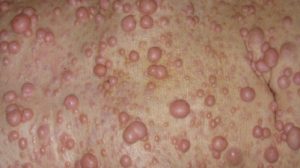Neurofibromatosis
Neurofibromatosis
This is a type of genetic disorder in which tumor arises on the nerve tissues. These can develop anywhere in the nervous system like brain, spinal cord, and nerves. They are usually benign tumors but it can be cancerous. There are two types of neurofibromatosis i-e Type 1 and Type 2.
Symptoms
Different types of neurofibromatosis presents with different symptoms:
Symptoms of neurofibromatosis 1:
- Cafe au lait spots means flat, light brown spots on the skin.
- Freckles appear in armpit and groin area.
- Lisch nodules means tiny bumps on the iris of the eye.
- Neurofibromas appear, which are soft, pea-sized bumps on or under the skin.
- Deformities of bone like scoliosis or bowed legs
- Optic glioma (tumors of optic nerve)
- Learning disabilities
- Short stature
Symptoms of neurofibromatosis 2:
- Gradual loss of hearing
- Tinnitus
- Poor balance
- Headaches
- If neurofibromatosis leads to the growth of schwannomas it will present as numbness in one arm or leg, facial drop, balance problems, cataract development.
Causes
Main cause of neurofibromatosis is the genetic mutation either passed on as hereditary material or result spontaneously at conception. NF type 1 is a result of mutation at chromosome number 17 which causes the loss of neurofibromin result in uncontrolled cell division. NF type 2 results from the mutation in chromosome number 22 which results in the loss of protein called merlin, resulting in uncontrolled cell division and tumor production.
Complications
- Neurological problems
- Visual problems
- Cardiovascular problems
- Skeletal deformaties
- Breathing problems
- Pheochromocytoma means Benign adrenal gland tumor
- Schwannomas development
Diagnosis
Diagnosis of this condition depends upon detailed medical history and complete general physical examination of the patient. Other tests include the following:
- Eye examination
- Audiometry for hearing examination
- Electronystagmography to record eye movements
- Brainstem auditory evoked response for assessment of hearing and balance problem
- Genetic tests
- Imaging tests like X-ray, MRI, CT scan
Treatment
Treatment options include
- Monitoring through routine checkup of skin, eyes, skeletal abnormalities or signs of early puberty.
- Surgical removal of tumor
- Stereotactic radiosurgery
- Auditory brainstem implants and cochlear implants to aid in hearing and balance problems
